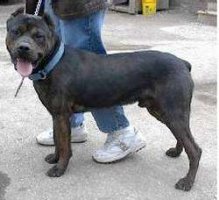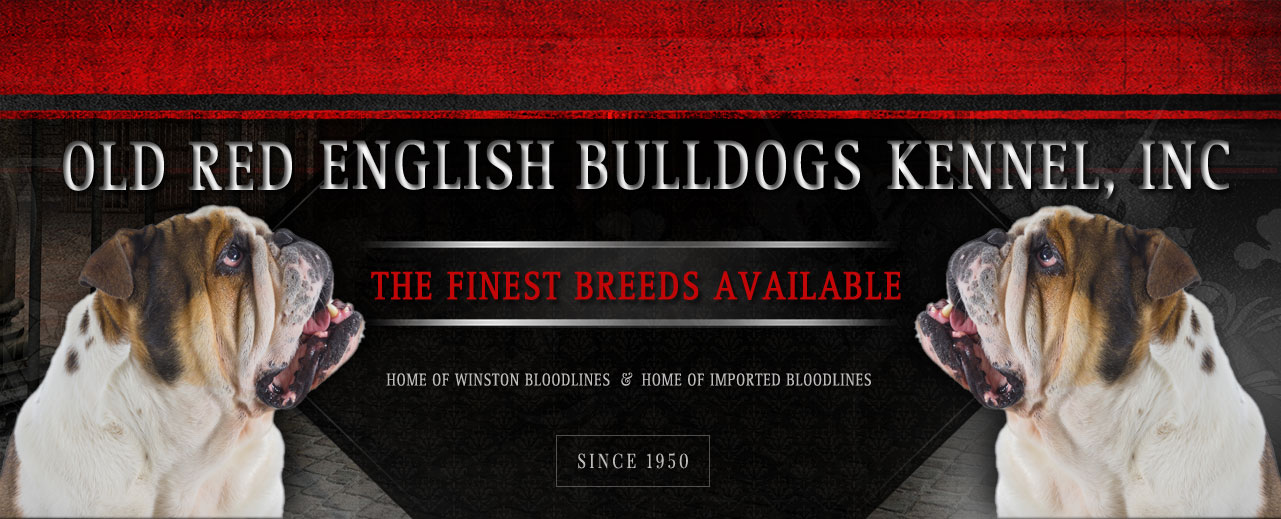
The American Mastiff Panja is a working dog with an athletic, muscular body. Their chests are wide, their limbs are muscular, straight, and well-boned, and their hocks are slightly angled. The breed has well-sprung ribs and a slight tuck-up. American Mastiff Panjas have small, almond-shaped eyes with an alert and inquisitive expression. Their heads are broad and their ears are cropped short. American Mastiff Panjas have dry mouths (they don’t drool) and their flews do not protrude. They have medium-length, flat coats that vary in color. The breed’s tail is docked to 1/3 of its natural length. The American Mastiff (Panja) has a curious and alert expression. The small eyes are wide set and almond shaped, with a classic, broad 60/40 head, widest at the ears. It has a scissor bite. The American Mastiff (Panja) should be “dry mouthed” and flews should not protrude. Ear crop is short, but NOT the “fighting” crop; natural ears are okay as long as they are the “button” style.
(This type of ear stands on its own; just the top 1/4 to 1/3 is turned down toward the front only.) American Mastiffs (Panja) are a true working dog with the muscular body of an athlete. Wide chest with well sprung ribs, slight tuck-up in the mid-section. Front legs must be straight and heavy-boned, with very muscular hindquarters, with slightly angled hocks giving the impression of instant action. Dewclaws are removed. The dogs must have a clean presentation. The tail dock is 2/3 off.
Character
American Mastiff Panjas have a laid-back attitude and a leisurely temperament. They make excellent pets and are very devoted and protective towards their family. Most American Mastiff Panjas (especially those being bred today) are terrific with small children. The breed’s natural instincts lead them to take responsibility over everything in their domain. They believe it is their duty to protect everything and everyone in their household. American Mastiff Panjas are an intelligent breed, and obedience training is recommended to prevent the onset of boredom or reckless behaviors like chewing. The breed is a natural-born guard dog, and they are great at alerting their owners of any suspicious activity. They are strong-willed leaders and have a dominating persona, but they are also very kind and loyal companions.
Temperament
The American Mastiff (Panja) has an easy-going attitude. They are very devoted to their families and are excellent with children when they are raised with them from puppyhood and/or properly socialized. The American Mastiff (Panja) will take on the responsibility of watching over everything in your home, including the cat; they think everything has to be protected. Obedience training and an owner who knows how to display authority over the dog are strongly recommended to channel its protective instincts. They are an active breed and love to play. As with most intelligent dogs, the American Mastiff (Panja) tends to get bored very easily and can be prone to chewing. They love to be around their people and require proper socialization; they are excellent travel buddies. Mention the word “car” and they go bananas! The most impressive thing about these dogs is their guarding habits; they know which of your guests are welcome in your home and treat them as family. These dogs require a firm handler. If you have very little experience with guard dogs then this is not the breed to start with. American Mastiffs (Panja) are strong-willed and want to be the alpha; that is what makes a great guard dog. They need an owner who knows how to show strong leadership. Anyone considering this breed would have to have experience with other large, dominant breeds. Not a breed for the meek owner. The objective in training this dog is to achieve pack leader status. It is a natural instinct for a dog to have an order in its pack. When we humans live with dogs we become their pack. The entire pack cooperates under a single leader; lines are clearly defined and rules are set. You and all other humans MUST be higher up in the order than the dog. That is the only way your relationship can be a success.
History
.Originally developed in Detroit’s Metro area, the early Panja Mastiff was a result of crossing Pit Bull Terriers, Rottweilers and Bandogs, although other breeds like the Bullmastiff, American Bulldog, Cane Corso, Doberman and the Presa Canario have reportedly been involved as well. The present-day Panja is more uniform in type and has a fairly specific “recipe” for its creation. This dog shouldn’t be confused with the popular bandog variety known as the “warlock”, which is simply a 1st generation APBT/Rottweiler cross, whereas the Panja can be achieved either by crossing two “warlocks” together or through planned matings of “full” Panja Mastiffs with Rottweilers.
Initially associated mostly with drug dealers and gangsters, the Detroit Rock Dog was often employed as a guardian of their properties and as a pit-fighter, but it was its common use as a “bodyguard” which earned the Panja its reputation as a personal protection breed. Even though it has unpleasant beginnings and somewhat dark roots, this is an increasingly popular breed today, thanks to the efforts of some responsible breeders that are producing dogs of sound temperament and agreeable personality. However, potential owners should research the breeders and try to avoid bloodlines known for overly vicious and unstable dogs, as well as poorly bred 1st generation crosses, which are still commonly encountered in the population to this day.
The American Panja Mastiff takes its guarding duties very seriously and can be fairly dog-aggressive, which is why it requires proper handling and socialization. However, when raised and handled properly, it can be a well-behaved and reliable companion. Athletic and agile, this wide-chested and muscular breed is affectionate and gentle with children, making a good family dog. There is still a variety of types to be found, depending on which breed’s influence is stronger in a specific bloodline, but most Panja Mastiffs are strong-boned, broad-headed and easy-moving Molossers. The ears can be cropped or left in their natural state. The tail is usually docked, but many unaltered specimens are commonly encountered.
The coat is flat and short, but quite dense and thick, accepted in a variety of colourings, from solid fawn, red and black shades to various bicolours, such as white-based particoloured and darker dogs with small white markings, as well as black-n-tan and tricoloured specimens.
Height
22 – 26 inches (56 – 66 cm)
Weight
80 – 100 pounds (36 – 45 kg)
General Health
The American Mastiff Panja doesn’t have any major health concerns to speak of, but like other large breeds of dogs, it’s possible that some specimens are at an increased likelihood of developing hip dysplasia. American Mastiff Panjas typically live for 10 to 12 years.
Grooming
The American Mastiff (Panja) has a medium, flat coat. They do grow an undercoat in the winter; daily brushing will keep the stray hairs under control in the shedding season. However, shedding for this breed is minimal. American Mastiffs (Panja) do not require special attention to any areas for grooming; just a good bath and rub-down once a month will keep your American Mastiff’s (Panja) coat in top condition.
Maintenance
American Mastiff Panjas have a medium-length, flat coat that doesn’t require much upkeep. They are minimal shedders, but a daily brushing is still a good idea to keep stray hairs at bay. A bath or dry shampoo can be administered as necessary.
Ideal Environment
The American Mastiff Panja can live acceptably in a small household or apartment if they are properly exercised. They are relatively inactive indoors and have a propensity to become lazy, so it’s important that their owners initiate some healthy activity. American Mastiff Panjas don’t like to be left alone, so keeping them in a crate while the owners are away is often recommended. They do well in all climates and can tolerate many various weather conditions. They are a breed that needs at least a small yard. Daily walks are ideal for this athletic breed.
These are the Bulldogs and Mastiffs we breed and sell.
The pictures on each page are for identification purposes and OldBulldogs.com does not own every animal pictured. These pages are informational and intended to describe the standards of each breed.
- Alano Español
- Alapaha Blue Blood Bulldogs
- American Bandogge Mastiffs
- American Bully-Bullies
- American Pit Bull Terriers
- American Staffordshire Bullies
- American Staffordshire Terriers
- Arkansas Giant Bulldogs
- Australian Bandogge Mastiffs
- Australian Bulldogs
- American Bulldogs-Old Time Southern Bulldogs-Old Southern Whites
- Banter Bulldogs
- Boxer Bulldogs
- Bull Terriers
- Bull Mastiffs
- Miniature Bull Terriers
- Mexican Bulldogs
- Miniature English Bulldogs
- Neapolitan Mastiffs
- Old Boston Bulldogs
- Olde English Bulldogges
- Old Victorian Bulldogs
- Patterdale Terrier
- Perro de Presa Canario
- Performance-Standard Type American Bulldogs
- Perro de Presa Mallorquin
- Panja Mastiffs
- Renascence Bulldogs
- South African Boerboel
- Staffordshire Bull Terriers
- Saint Bernard
- Valley Bulldogs
- Winston Working Bulldogs
- Winston’s Working Mastiffs
- Winston’s Working Terriers
- Winston’s Working Hounds
- Winston’s Working Shepherds
